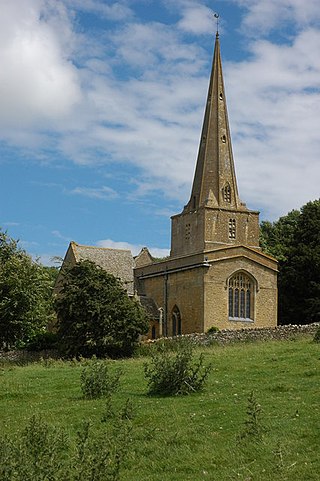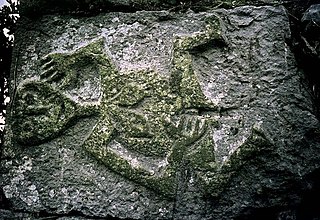
A sheela na gig is a figurative carving of a naked woman displaying an exaggerated vulva. These carvings, from the Middle Ages, are architectural grotesques found throughout most of Europe on cathedrals, castles, and other buildings.

Aughagower or Aghagower is a small village in rural County Mayo in western Ireland. It is 6 km south-east of Westport. Aughagower has around forty houses, a pub and a shop, with a clear view of Croagh Patrick from Reek View. It is also at the centre of Aghagower civil parish which covers an area of 86.1 square miles. The village is known for its links to Saint Patrick and Tóchar Phádraig, the pilgrimage route from Ballintubber Abbey to Croagh Patrick.

Royston Cave is an artificial cave located in Katherine's Yard, Melbourn Street, Royston, England. It is located beneath the crossroads formed by Ermine Street and the Icknield Way. It is protected as both a scheduled ancient monument and Grade I listed building. It has been speculated that it was used by the Knights Templar, who founded nearby Baldock, but this is unlikely, despite its enormous popular appeal. There are numerous theories about the Cave covering Freemasons and Templars as well as possibilities that the Cave was a prison or an anchorite cell. However, none of these theories have enough hard evidence to warrant their being adopted by the Cave Trust. It is open to the public in the summer months on Saturday, Sunday and Bank Holiday afternoons between Easter and October.

White Island is an island in Lower Lough Erne, County Fermanagh, Northern Ireland. It is situated in Castle Archdale Bay off the east shore of Lower Lough Erne. The ruins of an ancient church are found near the shore, built on the site of an earlier monastic settlement. It still has an intact arched Romanesque doorway. The Church and carved figures are State Care Historic Monuments sited in the townland of White Island, in Fermanagh and Omagh District Council area.

Barbara Freitag-Rouanet is a German-born Brazilianist, sociologist, author, and academic at Universidade de Brasília. Her family emigrated to Brazil in 1948 when she was 7.

Whittlesford is a village in Cambridgeshire, England, and also the name of an old hundred. The village is situated on the Granta branch of the River Cam, seven miles south of Cambridge. Whittlesford Parkway railway station serves the village.

The Church of St Mary and St David is a Church of England parish church at Kilpeck in the English county of Herefordshire, about 5 miles from the border with Monmouthshire, Wales. Pevsner describes Kilpeck as "one of the most perfect Norman churches in England". Famous for its stone carvings, the church is a Grade I listed building.

Kildare Cathedral, or St Brigid's Cathedral in Kildare, is one of two Church of Ireland cathedrals in the United Dioceses of Meath and Kildare. It is in the ecclesiastical province of Dublin. Originally a Catholic cathedral, it was built in the 13th century on the site of an important Celtic Christian abbey, which is said to have been founded by Saint Brigid in the 5th century. The site was taken over by the Protestant Church of Ireland following the Reformation. There is an Irish round tower in the cathedral grounds.

The Church of St Andrew in Clevedon, Somerset, England. Parts of the original 12th-century church remain with 14th- and 15th-century additions. It is on a hill overlooking the Bristol Channel, and has been designated as a Grade I listed building.

The Church of St Mary the Virgin at East Stoke in Stoke-sub-Hamdon, Somerset, England dates from the 12th century. It has been designated as a Grade I listed building. It was previously dedicated to Saint Denis.

Old Sakshaug Church is a preserved, former parish church of the Church of Norway in Inderøy Municipality in Trøndelag county, Norway. It is located in the village of Sakshaug, just west of the municipal centre of Straumen. It is the former main church for the Inderøy parish which is part of the Stiklestad prosti (deanery) in the Diocese of Nidaros. The stone church was built in a long church style around the year 1184 using plans drawn up by an unknown architect. The church seats about 200 people.

The townland of Doon in the civil parish of Tomregan is in the electoral district of Ballyconnell. It is also situated in the barony of Tullyhaw.

Liathmore Churches are two medieval churches forming a National Monument in County Tipperary, Ireland.

Clomantagh Castle is a 15th-century tower house located near Freshford, County Kilkenny, in Ireland. Originally constructed in the 1430s, additional buildings and outbuildings were added in the subsequent centuries - including a connected 19th century farmhouse. Carvings on the castle's walls include a Sheela na gig relief.

Castlemagner is a village, townland and civil parish in the Duhallow area of north-west County Cork, Ireland. Castlemagner is within the Cork North-West.

The Anglican Church of St Nicholas at Saintbury in the Cotswold District of Gloucestershire, England was built in the 13th century. It is a grade I listed building.

The Coolaghmore sheela na gig was discovered in 1975 at the 13th century church at Coolaghmore, County Kilkenny, Ireland during clearance work at the graveyard. It is thought to have been buried in the 19th century. According to local sources, it had been found in a well in Kyle previously and been brought to Coolaghmore Graveyard. It was then donated to Rothe House Museum via Kilkenny Archaeological Society where it is on display in a bricked up window in the shop of the first of the three houses since about 2012. The sites and monuments records number is KK019-026170.

The Kiltinan Church sheela-na-gig is a carved depiction of a nude woman exposing her vulva which used to be part of Kiltinan Church ruin near Fethard, County Tipperary as a quoin stone in the Southwestern corner of the church. However, it was stolen in 1990 and has not been located since. Fethard Historical Society issued a Wanted poster to help with the retrieval. The National Sites and Monuments no. is TS070-101003.

The Fethard Abbey Sheela-na-gig is located in a wall on the grounds of the former Augustinian Abbey in Fethard. Its National Sites and Monuments number is TS070-040030. One of its earliest mentions is in the School Collection which also includes a black and white photograph.

The Church of Saint Nicholas is a Church of England parish church in Studland, Dorset, England. It was built in the early 12th century on the foundations of an earlier Anglo-Saxon church. It is recorded in the National Heritage List for England as a Grade I listed building, and is a good example of a small, largely unaltered, Norman church.























